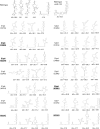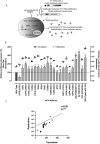Enhanced Virus Translation Enables miR-122-Independent Hepatitis C Virus Propagation
- PMID: 37338370
- PMCID: PMC10373559
- DOI: 10.1128/jvi.00858-21
Enhanced Virus Translation Enables miR-122-Independent Hepatitis C Virus Propagation
Abstract
The 5' untranslated region (UTR) of the hepatitis C virus (HCV) genome forms RNA structures that regulate virus replication and translation. The region contains an internal ribosomal entry site (IRES) and a 5'-terminal region. Binding of the liver-specific microRNA (miRNA) miR-122 to two binding sites in the 5'-terminal region regulates viral replication, translation, and genome stability and is essential for efficient virus replication, but its precise mechanism of action is still unresolved. A current hypothesis is that miR-122 binding stimulates viral translation by facilitating the viral 5' UTR to form the translationally active HCV IRES RNA structure. While miR-122 is essential for detectable replication of wild-type HCV genomes in cell culture, several viral variants with 5' UTR mutations exhibit low-level replication in the absence of miR-122. We show that HCV mutants capable of replicating independently of miR-122 display an enhanced translation phenotype that correlates with their ability to replicate independently of miR-122. Further, we provide evidence that translation regulation is the major role for miR-122 and show that miR-122-independent HCV replication can be rescued to miR-122-dependent levels by the combined impacts of 5' UTR mutations that stimulate translation and by stabilizing the viral genome by knockdown of host exonucleases and phosphatases that degrade the genome. Finally, we show that HCV mutants capable of replicating independently of miR-122 also replicate independently of other microRNAs generated by the canonical miRNA synthesis pathway. Thus, we provide a model suggesting that translation stimulation and genome stabilization are the primary roles for miR-122 in promoting HCV. IMPORTANCE The unusual and essential role of miR-122 in promoting HCV propagation is incompletely understood. To better understand its role, we have analyzed HCV mutants capable of replicating independently of miR-122. Our data show that the ability of viruses to replicate independently of miR-122 correlates with enhanced virus translation but that genome stabilization is required to restore efficient HCV replication. This suggests that viruses must gain both abilities to escape the need for miR-122 and impacts the possibility that HCV can evolve to replicate outside the liver.
Keywords: 5′ UTR; 5′ untranslated region; HCV; genome stability; hepatitis C virus; miR-122; miR-122-independent replication; translation; viral translation.
Conflict of interest statement
The authors declare no conflict of interest.
Figures







Similar articles
-
MicroRNA 122 Affects both the Initiation and the Maintenance of Hepatitis C Virus Infections.J Virol. 2022 Feb 23;96(4):e0190321. doi: 10.1128/JVI.01903-21. Epub 2021 Dec 15. J Virol. 2022. PMID: 34908444 Free PMC article.
-
Roles of the 5' Untranslated Region of Nonprimate Hepacivirus in Translation Initiation and Viral Replication.J Virol. 2018 Mar 14;92(7):e01997-17. doi: 10.1128/JVI.01997-17. Print 2018 Apr 1. J Virol. 2018. PMID: 29343570 Free PMC article.
-
MicroRNA-122 dependent binding of Ago2 protein to hepatitis C virus RNA is associated with enhanced RNA stability and translation stimulation.PLoS One. 2013;8(2):e56272. doi: 10.1371/journal.pone.0056272. Epub 2013 Feb 6. PLoS One. 2013. PMID: 23405269 Free PMC article.
-
The Role of the Liver-Specific microRNA, miRNA-122 in the HCV Replication Cycle.Int J Mol Sci. 2020 Aug 7;21(16):5677. doi: 10.3390/ijms21165677. Int J Mol Sci. 2020. PMID: 32784807 Free PMC article. Review.
-
Hepatitis C Virus Translation Regulation.Int J Mol Sci. 2020 Mar 27;21(7):2328. doi: 10.3390/ijms21072328. Int J Mol Sci. 2020. PMID: 32230899 Free PMC article. Review.
Cited by
-
MicroRNA-122 Regulation of HCV Infections: Insights from Studies of miR-122-Independent Replication.Pathogens. 2022 Sep 2;11(9):1005. doi: 10.3390/pathogens11091005. Pathogens. 2022. PMID: 36145436 Free PMC article. Review.
-
Poly(rC)-Binding Protein 2 Does Not Directly Participate in HCV Translation or Replication, but Rather Modulates Genome Packaging.Viruses. 2024 Jul 30;16(8):1220. doi: 10.3390/v16081220. Viruses. 2024. PMID: 39205194 Free PMC article.
-
MicroRNA 122 Affects both the Initiation and the Maintenance of Hepatitis C Virus Infections.J Virol. 2022 Feb 23;96(4):e0190321. doi: 10.1128/JVI.01903-21. Epub 2021 Dec 15. J Virol. 2022. PMID: 34908444 Free PMC article.
-
Translation Inhibition Mediated by Interferon-Stimulated Genes during Viral Infections.Viruses. 2024 Jul 8;16(7):1097. doi: 10.3390/v16071097. Viruses. 2024. PMID: 39066259 Free PMC article. Review.
-
Elucidating the distinct contributions of miR-122 in the HCV life cycle reveals insights into virion assembly.Nucleic Acids Res. 2023 Mar 21;51(5):2447-2463. doi: 10.1093/nar/gkad094. Nucleic Acids Res. 2023. PMID: 36807979 Free PMC article.
References
Publication types
MeSH terms
Substances
Grants and funding
LinkOut - more resources
Full Text Sources
Medical

